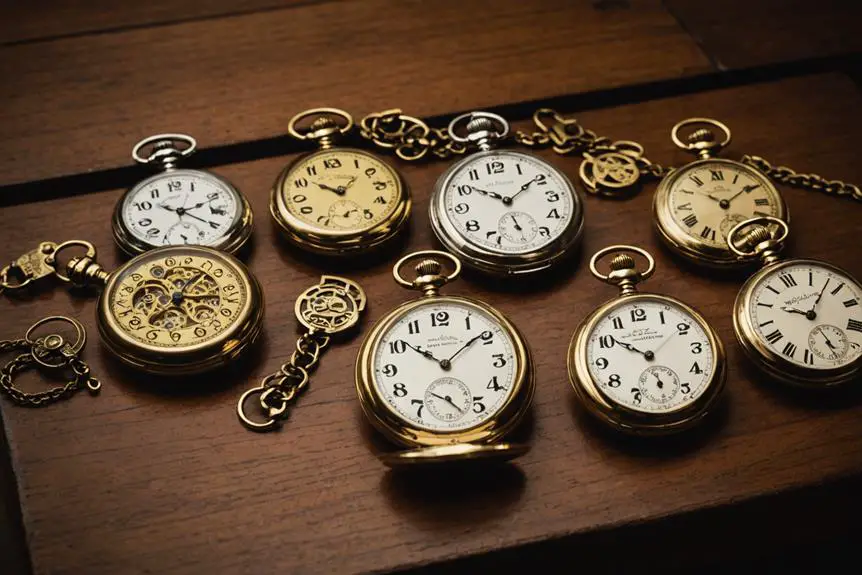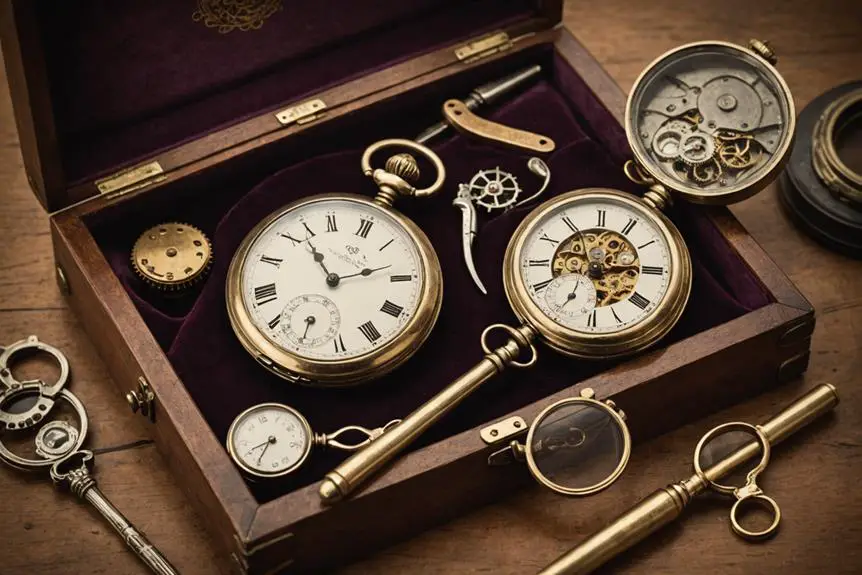Men's pocket watches in the 1920s symbolized elegance and sophistication, crafted from gold and silver to reflect one's status. These luxurious timepieces featured full hunter or open face designs, each catering to different needs for style and practicality. Notable brands like Elgin and Hamilton pushed the boundaries of craftsmanship with intricate engravings and jewel movements that enhanced both durability and appeal. As wristwatches gained popularity due to their convenience, pocket watches began evolving into heirlooms. Collectors now appreciate these pieces for their historical significance and artistry, a trend that continues to capture interest today in the world of horology.
Overview of 1920s Pocket Watches

The 1920s marked a pivotal era for pocket watches, characterized by a blend of intricate craftsmanship and luxurious materials. During this decade, the popularity of pocket watches peaked, signaling a significant moment in horology. You'd notice that many pocket watches were crafted from precious metals like gold and silver, reflecting the status and wealth of their owners. Among the styles, the Full Hunter pocket watch stood out, featuring protective covers that safeguarded the delicate face. In contrast, open face models allowed for quick time reading, catering to the needs of a fast-paced society.
As you explore this era, you'd find that decorative engravings and embellishments adorned many models, enhancing their aesthetic appeal and collector value. The Gold Filled Pocket Watch and Silver Pocket Watch were particularly prized for their opulence. Additionally, the emergence of the Art Deco Pocket Watch showcased bold designs and geometric patterns, aligning with contemporary artistic movements. While early models primarily utilized key-wind mechanisms, the introduction of quartz movements hinted at future innovations, though they remained rare. Finally, the Railroad Pocket Watch was essential for maintaining accurate timekeeping in the transportation industry, further underscoring the pocket watch's role in daily life.
Craftsmanship and Materials
Craftsmanship and materials in 1920s pocket watches reflect an era where artistry and precision reigned supreme. During this time, pocket watches weren't just timepieces; they were symbols of luxury and dedication to fine craftsmanship. You'd find various high-quality materials used, including:
- Gold-Filled Cases: Offering the look of gold without the hefty price tag, these cases were both durable and elegant.
- Jewel Movement: Many watches featured intricate movements with 7 to 23 jewels, like rubies and sapphires, enhancing durability by reducing friction.
- Ornate Cases: Full hunter models often showcased elaborate engravings and decorative enamel work, emphasizing the artistry involved.
Brands like Elgin distinguished themselves through their attention to detail, producing vintage pocket watches that not only told time but also told a story of craftsmanship. The combination of precious metals and intricate designs made these pocket watches highly desirable, ensuring their status as collectibles today. Each piece was a tribute to the skilled artisans who poured their heart into creating stunning timepieces that would stand the test of time.
Popular Brands and Models

In the bustling landscape of the 1920s, pocket watches emerged not only as essential timekeeping instruments but also as expressions of personal style and status. The 1920s pocket watch market was dominated by several key brands known for their craftsmanship and reliability. The Elgin Pocket Watch, particularly the 1921 model featuring a Grade 291 movement, exemplified the brand's commitment to quality.
Meanwhile, Illinois made waves with its Bunn Special, a railroad-grade pocket watch highly coveted by collectors for its precision and durability. This model was essential for train conductors, ensuring punctuality across the railroads. In 1927, Hamilton introduced the 992 model, which set a new standard for railroad timekeeping, boasting a 21-jewel movement that enhanced its reliability considerably.
The decade also saw the emergence of luxurious options, such as Tiffany & Company pocket watches. These timepieces combined elegance with high-end craftsmanship, appealing to those who valued both functionality and style. As you explore the offerings of these brands, you'll appreciate how they shaped the pocket watch landscape, catering to diverse needs and tastes in a rapidly changing society.
Pocket Watches as Status Symbols
Pocket watches of the 1920s transcended mere functionality, becoming powerful symbols of wealth and sophistication in a society enthusiastic to showcase its affluence. These exquisite timepieces, often crafted from gold or sterling silver, were more than just tools for telling time; they reflected the owner's status and taste.
Consider the following aspects that underscored their significance:
- Luxury Materials: Pocket watches were typically made from precious metals, emphasizing the owner's wealth.
- Prestigious Brands: Renowned manufacturers like Patek Philippe and Cartier produced high-quality pieces that were highly coveted, reinforcing their status as fashionable accessories.
- Artistic Craftsmanship: Many pocket watches featured intricate designs and decorative engravings, showcasing an appreciation for fine horology and individuality.
As you donned a hunter pocket watch, you weren't just checking the time; you were making a statement. These watches were often gifted during significant life events, solidifying their role as cherished heirlooms passed down through generations. In a rapidly changing world, pocket watches remained a steadfast symbol of elegance and refinement, capturing the essence of a prosperous era.
The Transition to Wristwatches

As the 1920s progressed, the allure of pocket watches began to wane, giving way to a new trend that reflected the changing dynamics of society. The rise of wristwatches marked a significant shift in timekeeping, driven by the active lifestyles of men during this era. Unlike the traditional gold pocket watches, which required a pocket watch chain for storage, wristwatches offered a level of convenience that was increasingly favored.
The influence of World War I also played an essential role; soldiers relied on wristwatches for tactical precision, establishing them as vital accessories. Innovations in watchmaking, such as smaller movements and waterproof cases, further facilitated this transformation. Brands like Omega and Elgin capitalized on these advancements, producing stylish and practical wristwatches that appealed to modern sensibilities.
Gifting Traditions in the 1920s
During the 1920s, gifting traditions surrounding pocket watches flourished, as these timepieces became synonymous with milestones and achievements. You'd often find pocket watches presented for significant events, reflecting status and sophistication, while celebrating craftsmanship and luxury. Gifting a pocket watch wasn't just about the watch itself; it was about creating a lasting memory.
Here are three key aspects of gifting traditions during this decade:
- Personalization: Many pocket watches featured engravings, making them unique and meaningful to the recipient.
- Presentation: Pocket watches were commonly presented in decorative cases or boxes, showcasing the giver's thoughtfulness and attention to detail.
- Heirloom Gifts: These timepieces often became cherished heirlooms, passed down through generations, signifying family legacy and tradition.
The intricate designs and precious materials of these watches exemplified the era's appreciation for fine craftsmanship. By gifting a pocket watch, you weren't just giving a luxury item; you were offering a piece of history, a symbol of achievement, and a token of lasting affection. This tradition created profound connections between generations, solidifying the pocket watch's place in the domain of meaningful gifts.
Collecting Vintage Pocket Watches

In the world of horology, collecting vintage pocket watches from the 1920s has become a fascinating pursuit for enthusiasts and investors alike. The intricate designs and craftsmanship of these pieces, often made from silver or housed in gold filled cases, make them highly desirable. Authentic watches from this era can range from $34.55 to over $7,600, depending on brand, condition, and rarity.
When you're on the lookout for collectibles, focus on key features like the movement type, decorative engravings, and whether the watch is an open face pocket model or a full hunter. Each aspect can greatly influence the pocket watch grade and market value.
Here's a brief overview of what to evaluate:
| Feature | Importance | Example |
|---|---|---|
| Movement Type | Affects timekeeping accuracy | Mechanical vs. Quartz |
| Case Material | Determines durability | Silver or Gold Filled |
| Signature | Indicates authenticity | Triple Signed watches |
Preservation and maintenance are critical; proper care enhances appeal. By understanding these factors, you can make informed decisions and build a valuable collection that captures the elegance of the 1920s.
Frequently Asked Questions
Did Men Wear Pocket Watches in the 1920s?
Yes, men did wear pocket watches in the 1920s, showcasing elegance and status. These intricate timepieces symbolized luxury, with designs ranging from full hunter to open face, made from precious metals and adorned with detailed engravings.
When Did Men Start Wearing Pocket Watches?
Men started wearing pocket watches in the 16th century, evolving from practical timekeeping devices to fashionable accessories. By the 19th century, their popularity surged, especially with the rise of the railroad and the need for precise timekeeping.
Why Did Men Stop Wearing Pocket Watches?
You'll notice men stopped wearing pocket watches due to the rise of wristwatches, which offered practicality and convenience. As modern lifestyles evolved, wristwatches became symbols of efficiency, overshadowing the traditional pocket watch's appeal.
How Do You Date an Antique Pocket Watch?
To date an antique pocket watch, you'll check the serial number, examine the movement and case for unique features, look for hallmarks, and research the brand's production records to pinpoint its manufacturing period accurately.



